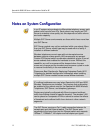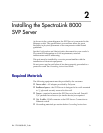
SpectraLink 8000 SVP Server: Administration Guide for SIP
PN: 1725-36033-001_C.doc
12
Notes on System Configuration
In an IP system using subnets to differentiate telephony areas, each
subnet must have its own APs. Each subnet may require an SVP
Server to maintain voice quality, but this depends on traffic volume
and router capacity.
Multiple SVP Server environments are those which have more than
one SVP Server.
SVP Server models may not be combined within one subnet. More
than one SVP Server model type may be used within a facility if
installed on different subnets.
Wireless telephones cannot roam with uninterrupted service
between subnets unless specific LAN components are present.
Certain AP/Ethernet switch combinations establish a layer-2 tunnel
across subnets that enables the handsets to roam. Without this
capability, any call in progress will be dropped when the user
moves out of range and the handset must be power cycled in order
to resume functionality in the new subnet area.
Please see Best Practices for Deploying Enterprise-Grade Wi-Fi
Telephony for detailed configuration information when installing
multiple SVP Server models across several different subnets.
IP multicast addresses are used when SpectraLink i640 and 8030
Wireless Telephones are installed. This requires that multicasting
be enabled on the subnet used for the SpectraLink 8000 Wireless
Telephones, SVP Server, and telephony gateways.
Routers are typically configured with filters to prevent multicast
traffic from flowing outside of specific domains. The wireless LAN
can be placed on a separate VLAN or subnet to reduce the effects
of broadcast and multicast traffic from devices in other network
segments.
The SVP Server requires a Cat. 5 cable connection between its
network port and the Ethernet switch. The SVP Server auto-
negotiates to the type of port on the Ethernet switch and supports
10Base-T, 100Base-T, full-duplex and half-duplex port types.


















